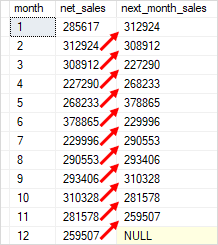
He is the leader of the New Zealand Business Intelligence users group. He wrote some books on MS SQL BI and also is writing some others, He was also an active member on online technical forums such as MSDN and Experts-Exchange, and was a moderator of MSDN SQL Server forums, and is an MCP, MCSE, and MCITP of BI. His articles on different aspects of technologies, especially on MS BI, can be found on his blog. Reza is also co-founder and co-organizer of Difinity conference in New Zealand. Reza is an active blogger and co-founder of RADACAD. He is a Microsoft Data Platform MVP for nine continuous years (from 2011 till now) for his dedication in Microsoft BI. He has a BSc in Computer engineering he has more than 20 years’ experience in data analysis, BI, databases, programming, and development mostly on Microsoft technologies. Reza Rad is a Microsoft Regional Director, an Author, Trainer, Speaker and Consultant. Here is complete books online for Lead and Lag functions: This is a sample result set of this script:

, datediff ( week, orderdate, lead ( orderdate, 1 ,null) over ( partition by customerid order by orderdate )) , lead ( orderdate, 1 ,null) over ( partition by customerid order by orderdate ) , datediff ( week, lag ( orderdate, 1 ,null) over ( partition by customerid order by orderdate ), OrderDate ) [Duration from Previous , lag ( orderdate, 1 ,null) over ( partition by customerid order by orderdate ) OVER statement structure is similar to row_number() function.īelow shows an very simple example of using Lead and Lag functions to find previous and next order dates of each customer, and the duration between previous and current order, and also between current and next order in weeks.ĬustomerID, OrderDate as Lag and Lead both are working with OVER Statement. Lag function works exactly similar, you just need to set source column, offset, and default value. This means that Lead(OrderDate,1,null) will return the value in OrderDate column from the very next record’s in the recordset, and if that record doesn’t exists it will return null (because of the default value configuration) you would require to define the source column, offset, and the default value. Structure of working with these functions is similar to each other. Lag function helps to access values from previous records, and Lead function helps to access values from next records in the data set. Lead and Lag are one of the most useful functions introduced in 2012. LEFT OUTER JOIN cte c2 ON c1.BusinessEntityID = c2.BusinessEntityID And c1.rn = c2.SQL Server 2012 has a set of useful functions to work in T-SQL environment. SELECT c1.BusinessEntityID, c1.QuotaDate, c1.CurrentQuota, IsNull(c2.CurrentQuota, 0) As PreviousQuota LAG(SalesQuota, 1,0) OVER (PARTITION BY BusinessEntityID ORDER BY QuotaDate) AS PreviousQuota

SELECT BusinessEntityID, QuotaDate, SalesQuota AS CurrentQuota, One only works if you database server is 2012 or later and 2) if you have a large amount of data, the first one will be much more efficient that the second one. For example, the following two queries do the same thing except that 1) the first In general what you would do is use the ROW_NUMBER function in a CTE to get a row number for each row, then join the cte to itself to get the LAGging or LEADing row. Asking a question in an old thread can result that many people who could answer your question will never see your question. Ideally, you would give a short description of your problem, sample table(s), sample data (in the form of CREATE TABLE and INSERT statements) and the resultĪnd you want to do that in a new thread that you start. We would need more information about you want. What's the alternative for a 2008 database using 2012 as the front-end?


 0 kommentar(er)
0 kommentar(er)
